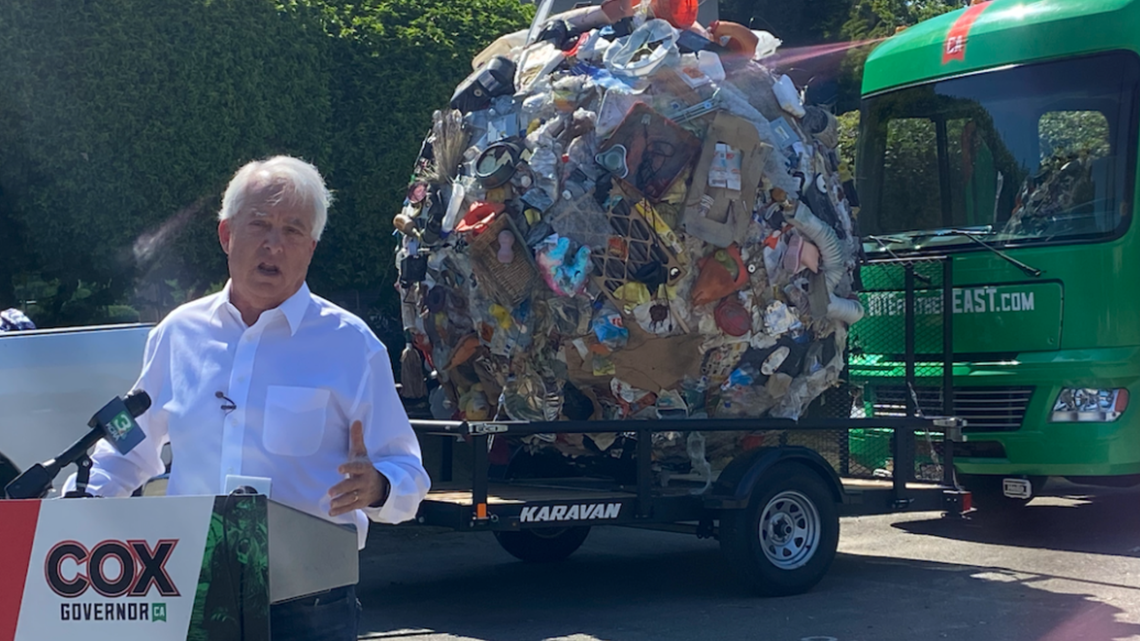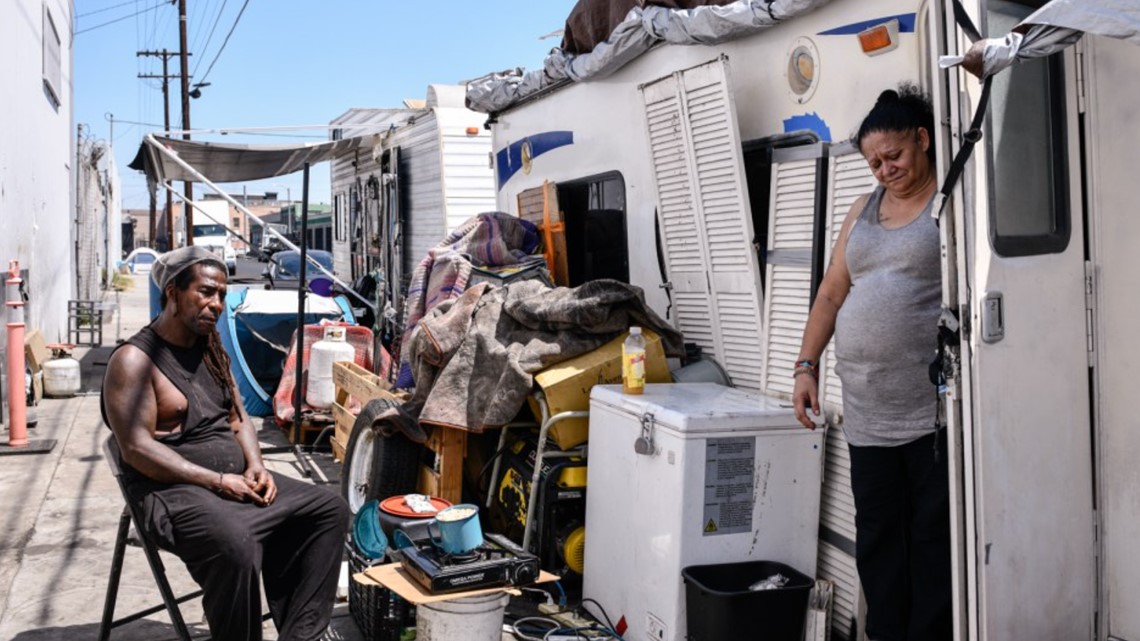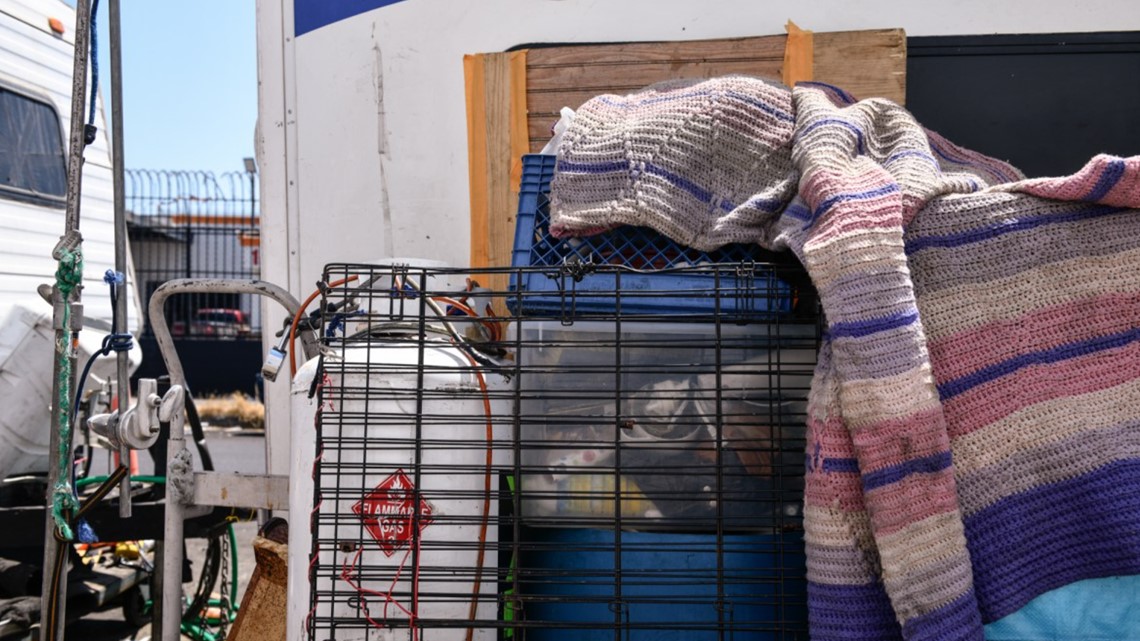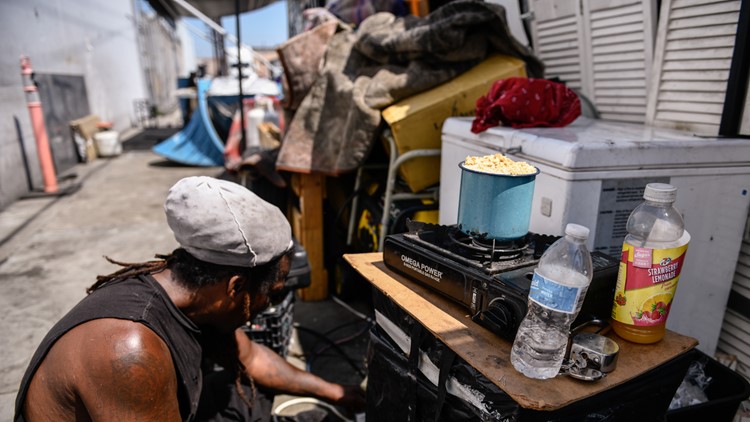CALIFORNIA, USA — This story was originally published by CalMatters.
The Gavin Newsom recall may have picked up steam as a referendum on the governor’s handling of the coronavirus pandemic, but now homelessness is also taking center stage.
Businessman John Cox — perhaps best known as the guy with the bear — has been hauling an eight-foot ball of garbage around California to symbolize “the trash that’s left behind” by people experiencing homelessness and the state’s response to them.
Kevin Faulconer, former mayor of San Diego, named homelessness as his number one campaign issue and put out several ads showing people camped in cars and tents in “Newsom’s California.”
Celebrity Caitlyn Jenner, best known for “Keeping up with the Kardashians,” noted in an interview with Sean Hannity of Fox News that a neighboring private plane owner had moved to Arizona because he couldn’t take seeing homeless people anymore.
While they’re proposing various solutions, the three Republicans agree: Homelessness is getting worse in California — and they can do better than the man they want to replace as governor.
Newsom made reducing homelessness a key part of his 2018 gubernatorial campaign, but the unsheltered population has only increased since then — up by 24% from 2018 to about 161,000 people in 2020. That was before the coronavirus pandemic upended the economy. (A scheduled count in January 2021 was postponed due to COVID-19.)
The increase is especially discouraging after the state has spent $13 billion on homelessness since 2018. A recent, scathing state auditor’s report points to a main culprit: a lack of coordination and accountability across the complicated web of state agencies and local counties, cities and service providers.
The rise also hasn’t been lost on potential voters, who see growing encampments under highways and along streets in many cities. A recent UC Berkeley Institute of Governmental Studies poll showed that while 49% of voters opposed the recall, homelessness loomed as a potential Achilles heel for Newsom: 57% of voters rated his job performance on the issue as poor or very poor and only 13% labeled it good or excellent.
And in a May poll by the Public Policy Institute of California, likely recall voters ranked homelessness the third most important issue in California, after only jobs and COVID-19, with housing costs and availability ranking fourth.
But is what the Republican challengers propose really that much better than what the state is already doing?
Their ideas reflect one school of thought on how to reduce homelessness, but some experts and advocates warn that while the policies might sound appealing, they could worsen the lives of those experiencing homelessness.
What comes first: Housing or treatment?
The United States has mostly embraced the “Housing First” strategy since the early 2000s. It was adopted by both George W. Bush’s and Barack Obama’s administrations, and has been law in California since 2016.
The idea is simple: Give people access to stable housing, and let job training and medical treatment follow. In other words, services aren’t a precondition to enter housing, but instead voluntary once the person is housed.
And yet, there’s a growing frustration, particularly among Republicans, that the strategy isn’t working. Robert Marbut, who served a stint as then-President Donald Trump’s homelessness czar, rejected the idea, and touted the opposite model: A person had to stay on the concrete parking lot outside a shelter and test negative for drugs before entering.
Doug Ose, a former Sacramento-area member of Congress running to unseat Newsom, proposes a similar method. “We need to stop enabling, excusing and ignoring these drug addiction and mental health issues,” he said in a recent interview.
Ose wants to make it easier to bring homeless people into the state’s custody, and then establish enough community care centers to treat drug addiction and mental illness. He also proposes that state-funded facilities demand sobriety from all individuals receiving services.


Cox also says the state has spent way too much money sheltering homeless people, and that they should be forced into mental health treatment instead.
“First, you’ve got to have treatment first, not housing first, treatment first,” he said at a recent press conference in Sacramento. “And yes, we’re going to have to force people into that treatment if need be.”
In his homelessness plan, Cox cites a Heritage Foundation blog post pointing to a study of “Treatment First” facilities that found nearly half of participants recovered from substance use, entered housing and maintained steady employment.
Neither Cox nor Ose has put forth a price tag for that treatment — but it is likely far higher than simply providing beds for people, as the current shelter model does.
The candidates do, however, have a point that more mental health treatment is sorely needed. Board-and-care facilities for low-income Californians with serious mental illness have been shuttering across the state at an alarming rate. The state budget for the next fiscal year includes $805 million for counties to purchase, build, preserve, or rehabilitate such facilities, but the state has yet to patch the growing hole in the availability and delivery of mental health treatment.
The prevalence of mental illness among the homeless is a source of debate, and being on the streets can worsen existing mental health conditions. There is general agreement among experts and elected officials that mental illness alone isn’t responsible for homelessness.
Of the more than 248,000 people who accessed homeless services throughout 2020, 41% reported disabling conditions, which could be anything from diabetes or a broken leg to a mental disorder, according to Ali Sutton, the state’s deputy secretary for homelessness at the California Homeless Coordinating and Financing Council.
Janey Rountree, founding executive director of the California Policy Lab at UCLA, said a recent study found that one-fifth of 37,000 people experiencing homelessness in Los Angeles had a clinically diagnosed serious mental illness.
“The people who are suffering from substance use disorder or mental illness are very visible, they’re very challenging,” she said. “But there is a very large unsheltered population that doesn’t have either.”
Margot Kushel, a professor of medicine at University of California San Francisco, who leads the UCSF Benioff Homelessness and Housing Initiative, also says there’s little evidence of correlation between mental health and homelessness.
Instead, she says the places with highest homelessness have a split population of high earners who can afford to pay housing costs, and those who can’t, competing for a limited supply of housing. Think: San Francisco.
Once people are living on the street, they’re much more likely to turn to drugs or alcohol, Kushel said.
“A lot of people on the streets use stimulants so they don’t sleep, because when they sleep, they get assaulted, and their stuff gets stolen,” she said. “Turns out that when you bring people inside and that goes away, people’s lives calm down, and they can engage in therapy.”
Kushel recently conducted a study in which researchers approached the 400 most chronically homeless people in Santa Clara — the people who most frequently ended up in the emergency room or jail you might find “yelling in the middle of the street” — and offered them a permanent home. All but one said yes.
Nearly 90% of the 169 participants placed in supportive housing — which included voluntary but not mandatory treatment — stayed in housing for several years.
“This is in California, the sickest of the sickest, and they mostly all got housed,” she said.


But if “Housing First” is really the answer, why isn’t homelessness declining?
One reason: The state is about one million housing units short for the lowest earners.
And rents are only increasing. A recent report by the National Low Income Housing Coalition found California to be the most expensive state for tenants, when compared to average wages. Renters would need to make at least $39 an hour to afford a 2-bedroom apartment in California, while the average renter makes less than $25 an hour, and the minimum wage is $14.
Rountree likened the situation to watering only 10% of the garden all summer and claiming watering doesn’t work because the other 90% of the garden died: “That’s what people are saying: ‘Housing first’ doesn’t work. But we haven’t actually housed anyone.”
According to the state’s database, of the roughly 248,000 people who accessed local homeless services last year, nearly 40% of those people moved into permanent housing — which could mean anything from moving in with a family member to getting their own place.
“Housing First” is “working faster and better than it ever has, it’s got more resources than it has in ages. Let’s not upset that piece that we know was working really, really well,” said Sutton, the state’s top official on homelessness. “The problem is much more the inflow, and how do we solve that.”
Forcing treatment
Several candidates in the Newsom recall mentioned using conservatorships, or legal guardianships, to force people into treatment. Both Cox and Ose suggest loosening the Lanterman-Petris Short Act, which limited involuntary treatment to those who are a danger to themselves or others, or gravely disabled, and limited the time for confinement.
Ose, for example, wants to change that definition to include anyone “addicted to drugs” and unwilling or unable to “make reasoned decisions consistent with being self-sufficient.”
Cox said: “Britney Spears doesn’t need a conservator. Thousands of Californians living on the streets are the ones that need conservatorships. And we have to force people to do it.”
Newsom and others have also called for limited expansion of conservatorships. Supporters argue it’s too difficult to get help for their relatives who need it under the strict definition of conservatorship. Others say the outdated system doesn’t address the needs of people dealing with substance abuse.
But Kevin Baker, legislative director for the American Civil Liberties Union’s California Center for Advocacy & Policy, said the candidates’ proposals raise serious concerns, and not just about the violation of people’s civil liberties. Turning this into reality would take “an army” of lawyers, judges and guards the state simply doesn’t have.
“If you put somebody in a conservatorship, they’re yours,” he said. “You have to house, clothe and feed them. You have all the obligations to them that you have to prisoners. If we’re going to house these people and take care of all their needs, why don’t we instead do that in a way that is supportive and voluntary and leaves out all the lawyers and guards and the judges and the court costs and everything else?”
Shelter or permanent housing?
Faulconer calls for an audit into the need for mental health services and how the state is spending that money. But his main idea is to create enough shelter beds to get everyone on the streets inside with services, including mental health treatment. Under his plan, if space in a shelter is available, a homeless person must take it.
How many beds would that take? A lot. The 2020 tally of homeless people found California had the highest share of people living on the streets, or unsheltered, at 70%.
Asked about a price tag, Faulconer said “the cost of not doing it is extraordinary.”
“People are literally dying on our streets. And my whole plan is about giving people the ability to get off the streets, out of an unclean, unsafe, unsanitary environment into one that is supportive with the services that they need,” he told CalMatters.
Faulconer cites a 12% reduction in homelessness in San Diego as evidence that shelters work but local critics have questioned that record.
While Newsom has added record numbers of shelter beds in the last year, he has prioritized more expensive individual hotel rooms, as opposed to the large shelters Faulconer suggests.
Meanwhile, Cox proposes doing away with shelters altogether, saying they are a waste of money. And many advocates agree. Shelter isn’t affordable housing, so continuing to invest in shelters doesn’t fix the underlying cause.
While advocates and homelessness researchers also acknowledge that existing shelter beds sometimes go unused, they blame the rules. Many shelters have strict curfews and don’t allow people to sleep with their partners, bring in pets or store their personal belongings. Most importantly, they don’t allow people privacy, a need that heightened when shelters became hotbeds for COVID-19.
“People want autonomy in their lives,” said Kushel, from UCSF. “These are adults.”
Chris Martin, policy director at the nonprofit advocacy group Housing California, said the state has increasingly shifted away from the congregate shelter model, including the most recent state budget bill. He says that Faulconer’s plan is inhumane. “It’s warehousing. It really is taking us backwards,” he said.


There are several important points where the candidates align, primarily the push to “clean up” the state. Newsom proposed more than $1 billion in the state budget to pick up trash along freeways and downtown areas. Faulconer proposes establishing the “right to public spaces,” which would require that parks, freeways and other areas be kept clear of debris.
Advocates say these plans stigmatize people who are unhoused: “They’re forced to live in that trash,” Martin said. “And oftentimes it’s not trash. It’s all they have in their life.”
The candidates also all agree: California needs more housing, and addressing the homelessness crisis is impossible without that. That’s the same argument Newsom has been making since his 2018 campaign. His challengers propose changes such as streamlining permits and costly environmental reviews. But none of the candidates offer a clear way around the political pressures that make housing construction so difficult.
Like his opponents, Faulconer says the state simply needs a better governor: “I believe this cries out for leadership at the statewide level.”
WATCH RELATED: How the pandemic is impacting San Diego's homeless communities (April 2020)



